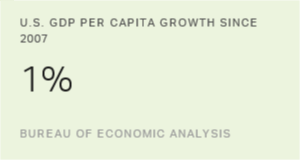PRINCETON, NJ -- U.S. unemployment, as measured by Gallup without seasonal adjustment, is 7.9% in mid-September, down 0.2 percentage points from August and a new low since Gallup began collecting employment data in January 2010. Gallup's seasonally adjusted unemployment rate remains unchanged at 8.1% in mid-September.
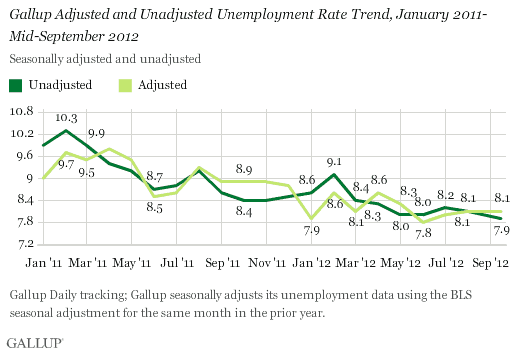
These results are based on Gallup Daily tracking surveys conducted by landline and cell phone from Aug. 16-Sept. 15, including interviews with more than 30,000 U.S. adults -- 68.1% of whom are active in the workforce. Gallup's seasonally adjusted unemployment rate incorporates the 0.2 upward adjustment used by the U.S. Bureau of Labor Statistics in September of last year.
The mid-September unadjusted unemployment estimate, if sustained throughout the rest of the month, would be the lowest monthly unadjusted rate since Gallup began tracking unemployment daily in January 2010. Gallup's unadjusted unemployment rate for September 2011 was substantially higher than now at 8.6%.
Fewer Part-Time Workers Seeking Full-Time Work
The percentage of Americans working part time but looking for full-time work is 8.6% in mid-September, as measured without seasonal adjustment, down from the 9.0% in August. This is also down from 9.7% a year ago and the lowest level for this measure since the 8.4% of November 2010.
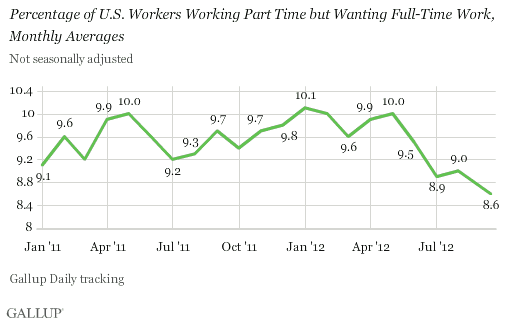
Underemployment Down From a Year Ago and at a New Low
Gallup's U.S. underemployment measure, which combines the unemployed with those working part time but looking for full-time work, is 16.6% in mid-September, down from 17.1% in August. The underemployment rate is also down substantially from 18.3% last September and is at its lowest level since January 2010.
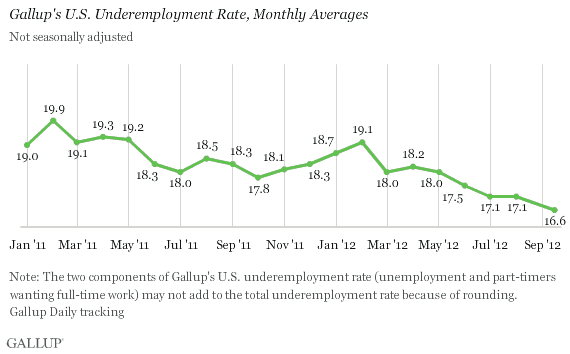
Implications
While unadjusted unemployment has improved so far in September, at least part of the improvement is likely due to a seasonal increase in hiring related to Halloween -- which is now a major sales period for the nation's retailers. In fact, the 0.2 seasonal adjustment that the government applied in September 2011 would suggest virtually all the improvement is seasonally related. Further, Gallup's unadjusted unemployment rate has remained between 7.9% and 8.2% since May -- implying a relatively flat job market. Still, the mid-September unadjusted unemployment rate, if maintained for the remainder of the month, is at a new low and is substantially below the 8.6% of a year ago.
It is also worth noting that the percentage of those working part-time but wanting full-time work is near the 8.4% low for this measure. As a result, the underemployment rate is at a new low. This is often seen as a good sign for the U. S. economy because it implies more part-time workers are getting full-time jobs.
Gallup's mid-September adjusted unemployment rate data suggest the BLS will announce no change in the government's seasonally adjusted unemployment rate for September in its early October reports. This seems consistent with the overall modest improvement in the job market over the past year and what appears to be a muddle-through economy in 2012.
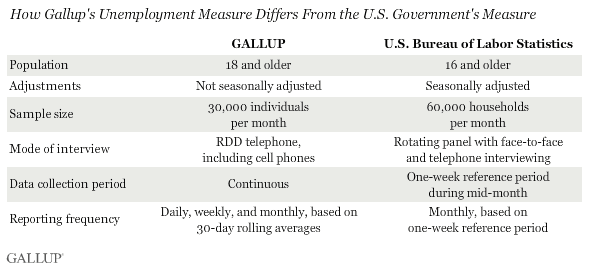
Gallup.com reports results from these indexes in daily, weekly, and monthly averages and in Gallup.com stories. Complete trend data are always available to view and export in the following charts:
Daily: Employment, Economic Confidence, Job Creation, Consumer Spending
Weekly: Employment, Economic Confidence, Job Creation, Consumer Spending
Read more about Gallup's economic measures.
View our economic release schedule.
Survey Methods
Results are based on telephone interviews conducted as part of the Gallup Daily tracking survey August 16-September 15, 2012, with a random sample of more than 30,000 adults, aged 18 and older, living in all 50 U.S. states and the District of Columbia, selected using random-digit-dial sampling.
For results based on the total sample of national adults, one can say with 95% confidence that the maximum margin of sampling error is ±1 percentage point.
Interviews are conducted with respondents on landline telephones and cellular phones, with interviews conducted in Spanish for respondents who are primarily Spanish-speaking. Each sample includes a minimum quota of 400 cell phone respondents and 600 landline respondents per 1,000 national adults, with additional minimum quotas among landline respondents by region. Landline telephone numbers are chosen at random among listed telephone numbers. Cell phone numbers are selected using random-digit-dial methods. Landline respondents are chosen at random within each household on the basis of which member had the most recent birthday.
Samples are weighted by gender, age, race, Hispanic ethnicity, education, region, adults in the household, and phone status (cell phone only/landline only/both, cell phone mostly, and having an unlisted landline number). Demographic weighting targets are based on the March 2011 Current Population Survey figures for the aged 18 and older non-institutionalized population living in U.S. telephone households. All reported margins of sampling error include the computed design effects for weighting and sample design.
In addition to sampling error, question wording and practical difficulties in conducting surveys can introduce error or bias into the findings of public opinion polls.
For more details on Gallup's polling methodology, visit https://www.gallup.com/.
.
